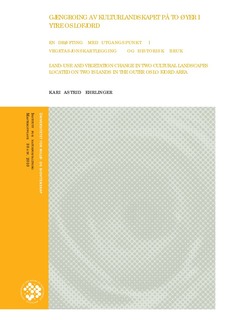Gjengroing av kulturlandskapet på to øyer i ytre Oslofjord : en drøfting med utgangspunkt i vegetasjonskartlegging og historisk bruk
Master thesis
Permanent lenke
http://hdl.handle.net/11250/187115Utgivelsesdato
2010-12-07Metadata
Vis full innførselSamlinger
- Master's theses (INA) [593]
Sammendrag
Når mennesket begynte å dyrke jorda og å bruke landskapet som beite for dyrene sine 4000- 6000 år
siden, satte det sitt preg på vegetasjonen, landskapet og de økologiske forholdene i jordsmonnet. All
landskap som er formet gjennom jordbruks- og skogbruksaktivitet kalles kulturlandskap. Den
ekstensive og mangfoldige driften av disse arealene har ført til et landskap med høyt artsmangfold.
Samtidig gjenspeiler det en stor del av vår kulturarv. I løpet av de siste 100 år har den tekniske
revolusjonen i landbruket ført til effektivisering og intensivering av næringen. Konsekvensen er at
den ekstensive bruken av marginale jordbruksområder legges ned og driften på det gjenværende
arealet intensiveres. Denne utviklingen gjenspeiles i statistiske tall som vitner om nedleggelse av
seterdrift og små bruk, avtagende sysselsetting i landbruket og fraflytting i bygdene. Som konsekvens
har kulturlandskapet opplevd en gjengroing av forlatte områder og kantsoner. Denne oppgaven skal
belyse problemstillingen rundt dette.
Oppgaven tar utgangspunkt i vegetasjonskartleggingen av Store Færder og Hvaløy, to øyer i Ormø -
Færder landskapsvernområdet, Vestfold. Området er vernet med formål om å ta vare på
kulturlandskapet i skjærgården øst for Tjøme og Nøtterøy kommune.
Store Færder er en øy som har vært i bruk som jordbruksområde siden 1696/1697, når Færder Fyr
ble etablert. Vegetasjonen har gjennomgått store forandringer siden øya ble fraflyttet i 1867. I dag
domineres øyas vegetasjon av tettvokst kantkratt og et mosaikk av tørr lynghei, kantkratt og
strandberg. Flere steder på øya kan vi fortsatt finne spor etter jordbruket for 150 år siden. Alle
vegetasjonstyper på øya bærer preg av gjengroing.
Hvaløys historie er ikke like godt dokumentert. Øya har en mer sammensatt vegetasjon enn Store
Færder og bære preg av å ha vært brukt som jordbruksområde til den dag i dag. Hovedparten av
vegetasjonen domineres av furuskog på grunnlendt mark og lavurtskog. Øya karakteriseres også
gjennom to store beiteenger, som er omgitt av et belte med eikeskog. Alle vegetasjonstyper på øya
bærer preg av gjengroing.
Denne oppgaven belyser problematikken rundt gjengroing av kulturlandskapet ved å belyse dets
fortid, nåtid og framtid. Tapet av kulturlandskapet innebærer tap av en viktig del av vår kulturarv og
biologisk mangfold.
Basert på mine resultater og diskusjon kommer jeg fram til at hvis ønsket er å bevare
kulturlandskapet med all dets verdier er det viktig å skjøtte landskapet på riktig måte. Ever since humans began to cultivate land and to use it as pasture for their animals 4 000 – 6 000
years ago, they left their mark on the vegetation, landscape and the ecological conditions of the soil.
Any landscape that is shaped through agricultural activity is called cultural landscape. The extensive
and varying use of these areas has led to a landscape with high biodiversity. At the same time, the
landscape reflects much of our cultural heritage. Over the past 100 years, the technological
revolution in agriculture has led to improved efficiency and intensification of this industry. As a
consequence, extensive used marginal agricultural areas are ignored, while use of the remaining
acreage is being intensified. This trend is reflected in statistics, observing the shutting down of small
farms, declining employment in agriculture and the depopulation of the countryside. Consequently,
the cultural landscape experiences an overgrowth of abandoned areas and border zones.
This study is based on vegetation mapping of Store Færder and Hvaløy, two islands in the Ormø -
Færder landscape protection area, Vestfold County. This area is protected for the purpose of
conservation of the cultural landscape in the archipelago east of Tjøme and Nøtterøy municipality.
Store Færder is an island that had been in use as an agricultural area since 1696/1697, when Færder
lighthouse was established. Since the island was abandoned in 1867 the vegetation has undergone
major changes. Today, the vegetation of the island is dominated by stocky edge scrub and a mosaic
of dry heath, edge thickets and shores. You can still find many traces of agricultural influence from
150 years ago on the island. But all vegetation types on the island show signs of overgrowth.
Hvaløy 's story is not as well documented. The island has more complex vegetation than Store
Færder and vegetation types reflect agricultural use until recently. The vegetation is dominated by
pine forest on a thin soil layer and low-herb forest type. The island is characterized by two large
grazing meadows, surrounded by oak forest. All types of vegetation on the island are developing
overgrowth.
This thesis aims to highlight the problems of overgrowth in cultural landscape by analyzing its past,
present and future. The loss of the cultivated landscape implies loosing big parts of our cultural
heritage and biological diversity.
Based on my results and discussion I come to the conclusion that conservation of the cultural
landscape and its values are only obtained by the right management and awareness.
